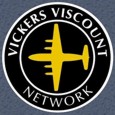
Vickers-Armstrongs


Museum search
Viscount Survivors
59 of the 444 Viscounts built survive as complete airframes or major components. Some are in very good condition and are looked after by museums while others are just wrecks. They can be found in 24 countries.
Viscount history
Discover the history of the Viscount with film, video, contemporary reports from the pages of Flight Magazine, our newsletters, and aircraft operational records and photos from our database.
Share your photos and stories
Our 'Live Magazine' is used by members and non-members to share their Viscount photos and stories with fellow enthusiasts located throughout the world in real time.
You are able to send in your photos, stories and comments by Facebook, Twitter or email and we will post them for all to enjoy.
Contact us
Join the Vickers Viscount Network
for FREE
Featured pages
Our website contains over 20,000 pages of photos and information that can all be accessed from the menu at the top of every page. Here are a few to get you started.
c/n 1 G-AHRF V.630
The Prototype Viscount
c/n 2 VX217 V.663
The Tay powered Viscount
c/n 3 G-AMAV V.700
The V.700 series prototype
c/n 4 G-ALWE V.701
The first BEA Viscount
c/n 5 G-ALWF V.701
The oldest surviving Viscount
c/n 8 F-BGNK V.708
The first Air France Viscount
c/n 30 EI-AFV V.707
The first Aer Lingus Viscount
c/n 40 CF-TGI V.724
The first TCA Viscount
c/n 44 VH-TVA V.720
The first TAA Viscount
c/n 67 YI-ACK V.735
The first Iraqi Airways Viscount
c/n 70 CF-GXK V.737
The first Canadian DoT Viscount
c/n 71 VP-TBK V.702
The first BOAC Associated
Companies Viscount
c/n 74 G-ANRR V.732
The first Hunting-Clan Viscount
c/n 77 LN-FOF V.736
The first Fred Olsen Viscount
c/n 79 IU-683 V.723
The first Indian Air Force Viscount
